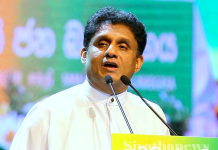Moody’s Investors Service downgraded Sri Lanka’s foreign currency issuer and senior unsecured ratings from B1 to B2 and changed the outlook to stable from negative on Tuesday.
This new development comes amidst political upheaval in the nation which has been noted as the prime reason for the decline in ratings of the island nation.
“The decision to downgrade the rating to B2 is driven by Moody’s view that ongoing tightening in external and domestic financing conditions and low reserve adequacy, exacerbated most recently by a political crisis which seems likely to have a lasting impact on policy even if ostensibly resolved quickly, have heightened refinancing risks beyond levels anticipated when the rating agency affirmed the rating at B1 with a negative outlook in July. Moody’s projections include a slower pace of fiscal consolidation than assumed in July to reflect disruption to fiscal policy implementation in a period of political turmoil,” the credit rating agency mentioned in an official statement.
“As a result, Moody’s expects government gross borrowing requirements, incorporating projections on fiscal deficits and maturing government debt repayments, to reach about 19% of GDP in 2018. In the meantime, interest payments will continue to absorb about 40% of government revenue, much higher than most B-rated sovereigns because of Sri Lanka’s high debt burden and significant borrowing requirements, as well as its low, albeit gradually rising, revenue base,” the agency noted.
The agency also predicts that the Sri Lankan government’s debt will remain above 75 per cent of Gross Domestic Product (GDP) in 2020, from about 77 per cent of GDP in 2017.
The agency marks that this figure is “higher than Moody’s previously expected and higher than many B-rated sovereigns”.
Delving deeper into their rationale behind the downgrades, Moody’s further underscored, “The stable outlook denotes balanced credit risks at the B2 rating level. Moody’s expectation is that, despite the current political crisis, any future government will remain broadly focused on implementing important fiscal, monetary and economic reforms that would strengthen the credit profile over the medium term. However, Moody’s assessment is that the government’s debt refinancing will remain highly vulnerable to sudden shifts in investor sentiment in a period of further tightening in financing conditions and political and policy uncertainty, with limited buffers to face such risk.”
The organisation also lowered the local-currency bond and deposit ceilings to Ba2 from Ba1 while the foreign currency bond ceiling was lowered to Ba3 from Ba2 and the foreign currency deposit ceiling was lowered to B3 from B2.
Highlighting the economic condition of Sri Lanka in the present political crisis, Moody’s further stated that Sri Lanka’s low foreign exchange reserve coverage of large external debt repayments over the next five years will worsen the nation’s reliance on external bilateral and commercial lenders’ willingness to refinance maturing debt.
“The risks related to that structural external vulnerability are rising in an environment of tightening financing conditions globally and, most recently, heightened domestic political tensions which threaten to undermine international investors’ confidence and the flow of foreign capital, from private markets and international bilateral lenders, into Sri Lankan financial assets,” the organisation said.
Moody’s further noted that the political turmoil has resulted in the delay to the disbursements planned under the International Monetary Fund (IMF) programme.
“A prolonged pause in the IMF programme, associated with uncertainty about the direction of policy, would likely undermine investors’ confidence, exacerbating the tightening in financing conditions,” the credit rating agency said.
Moody’s had earlier expressed concerns that the ongoing political crisis in Sri Lanka has caused the ‘credit negative’ to the island nation as the recent happenings have heightened policy uncertainty in October this year.
The statement released by the agency further talked about the depreciation of the Sri Lankan Rupee that is a result of the political instability in the country. It said, “Tightening external financial conditions and domestic political instability are resulting in capital outflows and placing increasing pressure on the exchange rate and foreign exchange reserves.”
“In addition, spreads on Sri Lankan bonds over US Treasuries have widened sharply in recent weeks to more than 550 basis points. Combined, these factors are raising the value and cost of external debt,” the agency inferred.
Moody’s suggested that the government could consider a range of options from the current point. “The government may pursue a range of financing options, including international US dollar bond issuance, yuan and yen-denominated bond issuances, and loans from China (A1 stable), the Middle East or other bilateral and multilateral lenders,” the agency said while sending out cautionary signs that these options “may mitigate but are unlikely to materially reduce refinancing risks, as ongoing tightening in financing conditions raise uncertainty around the timing and availability of funding sources.”
The agency also stated that volatile domestic political conditions undermine institutional strength in Sri Lanka while highlighting that the credit-rating agency does not expect a rapid resolution of the political crisis.
“Sri Lanka’s large government debt burden and weak debt affordability — along with sizeable external and foreign currency borrowing needs, lower capital inflows and higher financing costs — weigh on Sri Lanka’s already very low fiscal strength and broader credit profile,” the statement mentioned.
The stable outlook, on the other hand, denotes balanced risks at the B2 rating level. The rationale behind this is that Moody’s expects that the broad direction of policies by the government will remain focused on gradually narrowing fiscal deficits and lowering government debt which will be independent of political shocks.
Moody’s could up the ratings if it concludes that Sri Lanka’s vulnerability to refinancing risk is likely to diminish. The implementation of reforms that “significantly” lower fiscal deficits and government debt, while lowering government liquidity risks and external vulnerability risks could also prompt Moody’s to upgrade the rating.
On the other hand, Moody’s also outlined that if external and domestic financing conditions deteriorate “further than expected”, the agency would further downgrade Sri Lanka’s ratings.
Sri Lanka has been reeling from a turbulent political crisis for almost a month, when President Maithripala Sirisena on October 26 abruptly sacked then-Prime Minister Ranil Wickremesinghe and installed the now-ousted Mahinda Rajapaksa, the country’s former President, as the new premier.
The power struggle has left the Sri Lankan democratic system in tatters, with massive protests being held by the United National Party (UNP), where its members and supporters of Wickremesinghe have repeatedly called President Sirisena’s move as “unconstitutional”.
Sirisena then went on to dissolve the Parliament, following which he announced snap polls for January 5, 2019, which have now been suspended by the country’s apex court.
The high-voltage political crisis is now hanging in a limbo, as political parties wait for the Supreme Court’s verdict next month to see if the House will be dissolved and elections will be announced or whether the Wickremesinghe-led government will continue in office.












